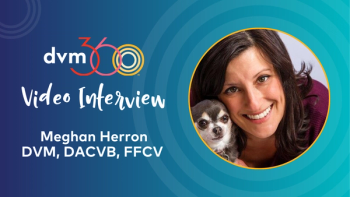
(Dont) use the force for scale stress and handling hang-ups
Scale back on stress and address handling hang-ups of older pets with these tips to take fear and suffering out of veterinary care.
Shutterstock.com
Editor's note: This is the third article in a series of stress-reducing tips that include strategies for pet owners to try at home before the pet reaches your clinic. Keep an eye on
“Fear is the path to the dark side. Fear leads to anger. Anger leads to hate. Hate leads to suffering.”
-Yoda
It's time to focus on the light side of veterinary care with force-free handling techniques that help pets happily comply with their healthcare. Sound impossible? It's not, but it does require work, especially for older pets who may already be conditioned to fearful responses.
Prevention is key for keeping animals comfortable and relaxed with veterinary care. But many dogs and cats have missed out on the prevention side and are dealing with fear, anxiety and stress (FAS) issues.
But even for these pets, it's not too late to make a positive difference in alleviating FAS and making drastic improvements to protect their emotional experience during care. Emotionally protective veterinary care is geared to prevent FAS and to alleviate FAS that already exists. Working with pet owners, your veterinary team can help keep the veterinary care experience as calm and carefree for the pet as possible. Here are key ways to help pet owners' complement your veterinary team's efforts:
Scale stress and exam table woes
The vet team's part:
> Prevent the slip. Slippery surfaces are scary, especially if you pull the cat or dog onto the space or pick them up and place them on an elevated area. The better approach: Lure them onto the scale. Putting non-slip pet mats, like the Pet Vet Mat, a bath mat or fleece blanket or pad with a grip bottom (consider a grip surface placed beneath, like a yoga mat), onto the surfaces makes the area more inviting for the animal.
> Gently warm a towel or the fleece pad that's placed on top of the nonslip surface. This makes it an inviting bed space. Place a trail of treats that leads onto the space.
> Mix it up. Don't forget the power of switching up the scene to improve the space for pets. If the dog or cat dislikes the exam table, consider other performing the exam in spaces they may feel more relaxed. For example, the pet's carrier, the floor, a chair, a bench or even a lap may work better for some pets.
Read body language to gauge your patient's comfort with the scale. | Shutterstock.com
The pet owner's part:
>
To boost the pet's happy association with the area, teach the animal to willingly go the the mat using a word like “mat” and then follow up with actions that encourage the pet to move onto the area, such as dropping treats leading from the floor onto the space in Hansel-and-Gretel fashion. Once the pet reaches the area, reward her for staying on the space by gently dropping or handing treats intermittently as the pet remains on the mat space.
Next, use a word like “free” or “break” to let the animal know the exercise is done and they can move off the mat. Toss a treat or lure the cat or dog away, then pick up the mat for the next session. The move-away can also serve as a reset so the pet can be ready for another try at moving onto the mat on cue.
Once the dog or cat begins to happily move onto the mat area, you can also place the portable mat space on other surfaces, including on top of a piece of sturdy, elevated furniture, such as a chair or the couch, to practice having the pet in higher spaces similar to the scale and exam table.
Handling hang-ups
The vet team's part:
> Keep pets comfortable. Consider ways to handle pets in a comfortable position. In most cases less is more when it comes to restraint. If you're incorporating tools into the handling for safety, such as muzzles and Elizabethan collars, condition these tools as positive for the pet during the visit.
> Practice with the tools of the visit. For animals that have had stressful experiences in the past with the veterinary tools you use-thermometers and otoscopes, just to name a few-offer follow-up guidance through
> Use tools and strategies to minimize and alleviate fear, anxiety and stress as much as possible. The
Fear Free measures also include the provision of preemptive pain control measures during handling or procedures that are anticipated to be painful or uncomfortable for the pet-as pain prevention is key for ensuring the experience remains as comfortable and positive as possible.
> Watch for and respect signs of stress and requests for space that dogs or cats give during handling to ensure you make adjustments before the animal progresses to bigger displays to show they're uncomfortable and need space.
> Use food distractions during handling to keep the animal focused on the positive. In addition to pairing a pleasurable outcome that can improve emotional associations with the veterinary experience, food distractions also serve as a gauge to help to better assess the animal's ongoing stress levels. Changes in how the animal is eating, including pausing, taking treats harder or snatching them, or suddenly not eating, can be telltale indicators of fear, anxiety and stress.
> Note and act on the little signs of stress to help the visit stay relaxed for the animal by only progressing at a pace the pet is comfortable with. The Fear Free Certification program has indicators for starting points, pause points and stopping points that can help guide the handling process.
> Use the mat. The animal's mat can also indicate the pets' comfort level, and you can use it during handling to build on the home training. You can also practice mat training during Victory Visit sessions that help build up the animal's comfort and familiarity.
The pet owner's part:
> Guide the pet owner to build on the mat training by incorporating short periods of handling when the dog or cat is on the mat to build the animal's comfort with touch at different stations in the practice.
> Have owners start with easy handling in the mat area, like touching the chest or shoulder of the dog or the cheeks or head of the cat. Ideally have the animal initiate this contact if possible.
> Start initially with just a moment of brief touch, and mark the pet's behavior with a word like “good” or “treat” and a treat reward. Instruct the pet owner to keep most handling sessions short, at 30 seconds to two minutes, to ensure the session is positive and happy.
> Teach patients-and pet owners-about the power of the mat area. Animals that lean away or move off the mat area during handling are giving a clear cue that they're uncomfortable and that handling should stop. Regular use of the mat teaches pets that their moving off and away cues the handling to stop and avoids bigger warnings, like growling or snapping. Veterinary team members can then make adjustments to keep a patient comfortable and relaxed.
> Honor pets' “voice and choice” to stay or move away, and many times the animal will start to relax and become increasingly comfortable. You may also choose to incorporate other tools, like muzzles, calming caps and towels, alongside other types of gentle control to ensure handling and procedures are as safe and as minimally stressful for pets as possible.
You don't want to use “the force” with pets. As the great Jedi Master Yoda once said, “Fear leads to anger. Anger leads to hate. Hate leads to suffering.” And we can avoid most of these unhappy interactions with Fear Free, force-free techniques that offer a better experience for pets, pet owners and the veterinary team.
Mikkel Becker, CBCC-KA, CPDT-KA, CDBC, CTC, KPA Graduate, BA Communications, is the resident trainer for vetstreet.com and works in conjunction with veterinarians and veterinary behaviorists to address behavior issues in dogs and cats. Her four-legged best friend is Willy the pug, a certified therapy dog through the Delta Society.
Newsletter
From exam room tips to practice management insights, get trusted veterinary news delivered straight to your inbox—subscribe to dvm360.






